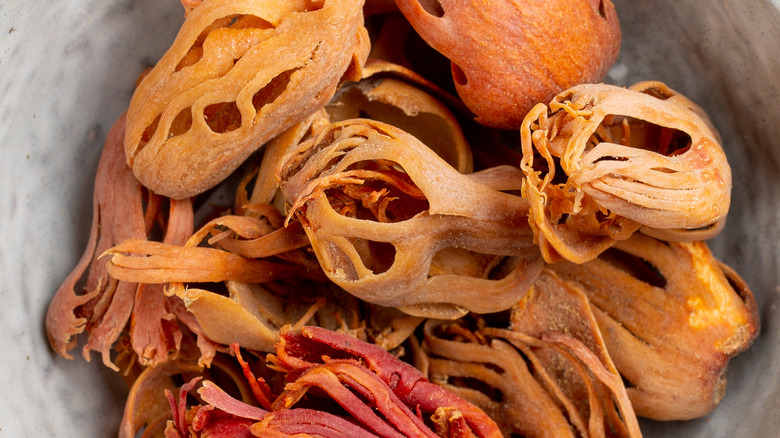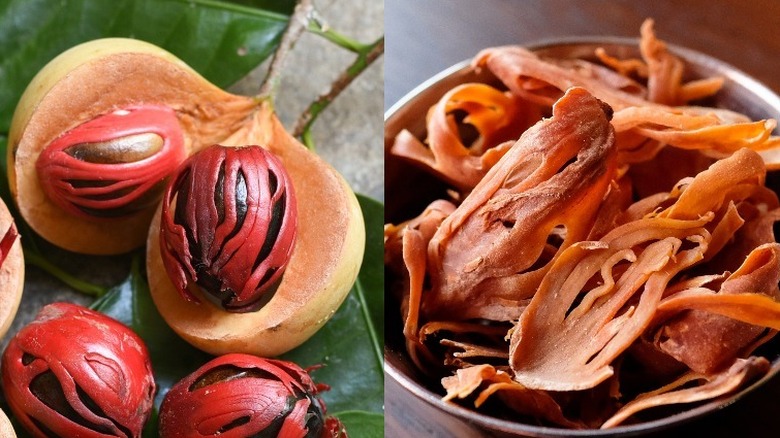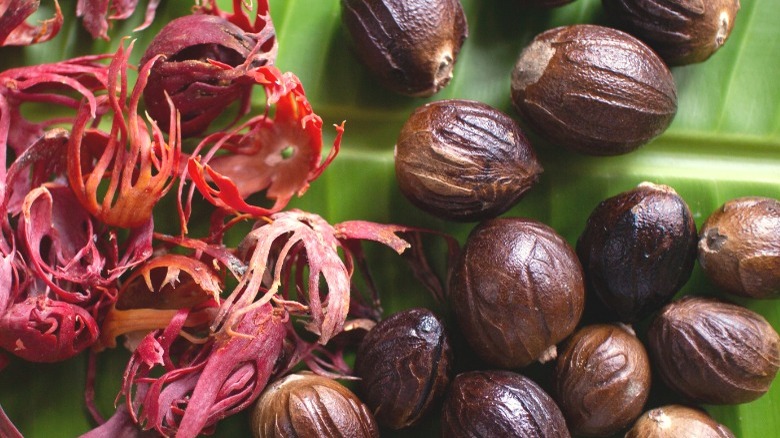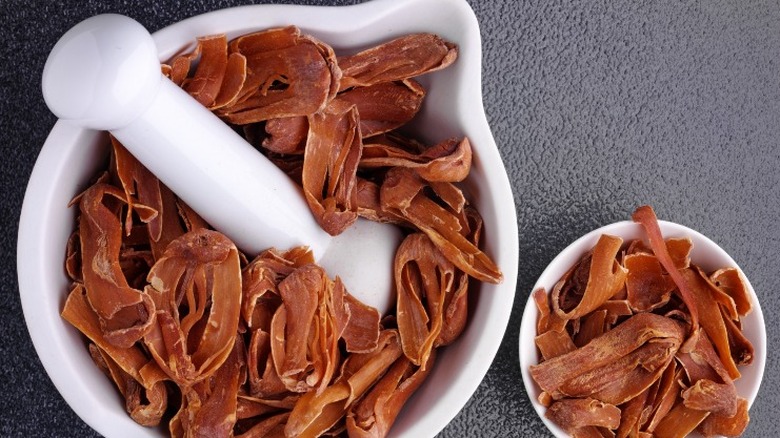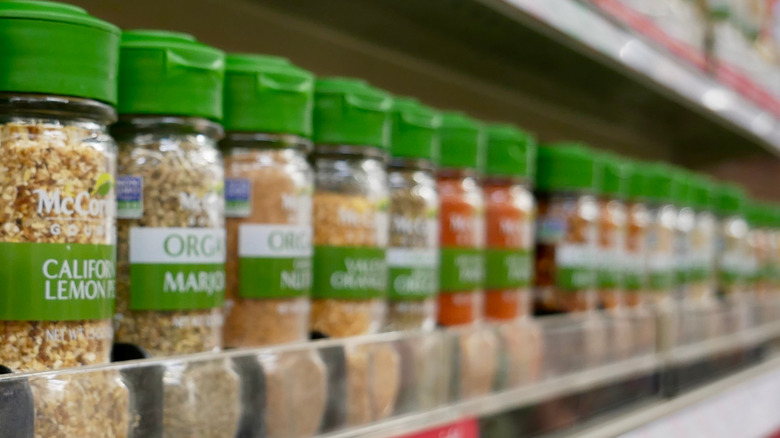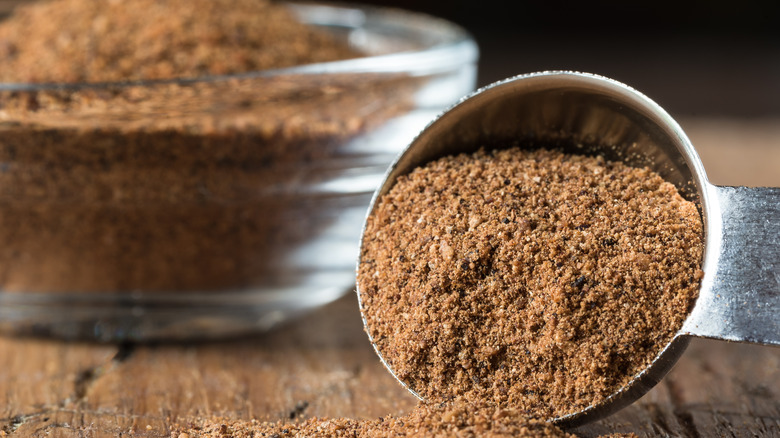What Is Mace And How Do You Cook With It?
What comes to mind when people see the word "mace" may vary greatly, and might well include images of pepper spray canisters or medieval weaponry. However, if mace is in the ingredients list of your recipe, rest assured that there'll be no violence involved. That's because mace is actually an intriguing spice that works beautifully in both sweet and savory dishes.
Mace tends to be neglected in the spice cabinet: What a shame! The flavor is complex, sweet, and a little spicy. Within that flavor web there's also a resemblance to the familiar whole spice that mace grows with — or rather, around — nutmeg.
Mace is a common ingredient in spice blends like garam masala, ground curries, and the Moroccan spice blend ras el hanout. Ground mace is delicious sprinkled into custards and cake batters, or when added in whole pieces to simmering stews, where it slowly releases its flavor. Here's all you need to know about the spice mace, including how to cook with it, where to find it, and what it tastes like.
Here's what mace is really
According to Britannica, mace is a coating that grows around nutmeg. In its fresh state, mace has this stunning crimson color that you see above, in tendrils that cling tightly to the surface of nutmeg seeds. Both mace and nutmeg are at the center of a fruit that grows on the evergreen tree Myristica fragrans. These tropical trees are native to Indonesia and also grow in parts of the Caribbean islands. Though you might assume from the name that nutmeg is a type of nut, it's actually the pit of this evergreen tree fruit, which makes it a seed. Mace is an aril, which Brittanica shares is the botanical term for a seed coating.
The vividly red mace is slipped off of nutmeg seeds by hand and then dried for up to two weeks. Whole mace are called blades and they have an odd appearance, almost like little dried octopuses or something out of an episode of "Doctor Who." As the blades dry, the red fades to a yellowish-orange color. Mace can be stored and used whole, or the blades can be ground. As with other spices like peppercorns and cardamom, whole mace will have a stronger and longer-lasting flavor than ground. Use a spice grinder to grind just the amount of mace you need.
Do mace and nutmeg taste the same?
Mace may carry some of the flavor notes of the seed it wraps around, but it's definitely not the same as nutmeg. (Which makes sense. Otherwise, why bother to harvest it?) Mace will bring hints of nutmeg to the tongue but is also more complex. It also has a spiciness like cinnamon or pepper, and citrusy notes as well. The flavor of mace is more intense than that of nutmeg, in much the same way that citrus peels have a deeper, more heightened flavor than the fruit inside. There is even a resinous quality in this evergreen-born spice.
Because mace the spice shares its name with the self-defense spray called Mace, people assume that the spice mace is used to make the spray. However, the Pepper Spray Store clears this up: They say that the product trademarked as Mace was named for the scary, medieval battle club known as a mace — a logical association for a product used to protect oneself. Mace products include some pepper sprays made with hot pepper compounds, but they are not made with the spice named mace. This nutmeg relative may have a strong flavor, but it's definitely not potent enough to be turned into a weapon!
How to cook with mace
It may be unfamiliar (and yes, the whole blades are peculiar-looking), but don't be afraid to try mace in both sweet and savory dishes. Recipes calling for mace usually mean ground mace. If you have whole blades of mace, try toasting them for a few minutes in a hot skillet to heighten the flavor and aroma, then grind them down in a mortar or a spice grinder. Add the ground mace to hot drinks and baked goods. Not sure where to start? The Spruce Eats suggests thinking of dishes where you enjoy the flavor of nutmeg and try them with ground mace instead. (Eggnog, anyone?)
Mace is delicious sprinkled over fresh fruits or veggies like asparagus and squash and also in glazes and dressings. You can also add mace to creamy pasta sauces and in sweets like pies and cakes. And we're loving Serious Eats' idea of adding mace to whiskey cocktails: This aromatic spice will really elevate a Hot Toddy or easily stand in for some of the bitters in an Old Fashioned.
You can also use whole or broken mace blades to flavor your cooking. Drop mace blades into a pan of simmering rice or add them to pickling spice blends for your next batch of pickles.
Where to buy mace
Although the spice can be a little more expensive, the good news is that ground mace is not too difficult to find. Look in the spice aisle at your grocery store or market for small bottles of ground mace. Check the containers for a pack-by date, which is a more reliable indicator of spice freshness than expiration dates, to make sure you're buying the most flavorful mace possible. Two brands that make ground mace and are easy to find at groceries are McCormick and Morton & Bassett.
If you have bulk spice stores in your area, it's worth looking for whole mace blades. These will likely cost more than ground mace, but the advantage is that more of the natural oils are retained in the whole blades than in ground — this means a more potent flavor for your dishes. And as with any whole spice, you're able to grind only as much as you need for your recipes. Store whole or ground mace in sealed jars away from light and moisture.
Online spice shops are also a great source for whole and ground mace. Sellers like Penzeys make it their mission to track down and offer unique and less readily available spices like mace blades, and are also a safe bet for the quality and freshness of the spices that it sells.
What can I substitute for mace?
When you can't track down any mace, or if a time crunch means you just have to make do with spices you have on hand, there are some spices you can substitute for mace. The recipe you're making should guide you in which spice you choose, depending on if you want to enhance savory or sweet flavors in your dish. You can substitute ground allspice or nutmeg for mace in recipes where you want warm spice notes to be present.
It's best to use a little less nutmeg than the amount of mace indicated in the recipe, and half as much if substituting allspice; then taste your mixture before adding more. Another option is to try cinnamon or ground ginger in place of mace.
The flavor of mace has elements of citrusy coriander and the spicy heat of black pepper. So when you're looking at spices to substitute for mace, in addition to nutmeg or allspice try adding a small amount of ground coriander or a few grinds of black pepper. These spices will be especially delicious in savory dishes that call for mace, like vegetables, pasta sauces, and meats.
